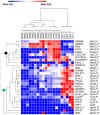Novel Genetic Determinants of Dental Maturation in Children
- PMID: 36437532
- PMCID: PMC10083589
- DOI: 10.1177/00220345221132268
Novel Genetic Determinants of Dental Maturation in Children
Abstract
Dental occlusion requires harmonious development of teeth, jaws, and other elements of the craniofacial complex, which are regulated by environmental and genetic factors. We performed the first genome-wide association study (GWAS) on dental development (DD) using the Demirjian radiographic method. Radiographic assessments from participants of the Generation R Study (primary study population, N1 = 2,793; mean age of 9.8 y) were correlated with ~30 million genetic variants while adjusting for age, sex, and genomic principal components (proxy for population stratification). Variants associated with DD at genome-wide significant level (P < 5 × 10-8) mapped to 16q12.2 (IRX5) (lead variant rs3922616, B = 0.16; P = 2.2 × 10-8). We used Fisher's combined probability tests weighted by sample size to perform a meta-analysis (N = 14,805) combining radiographic DD at a mean age of 9.8 y from Generation R with data from a previous GWAS (N2 = 12,012) on number of teeth (NT) in infants used as proxy of DD at a mean age of 9.8 y (including the ALSPAC and NFBC1966). This GWAS meta-analysis revealed 3 novel loci mapping to 7p15.3 (IGF2BP3: P = 3.2 × 10-8), 14q13.3 (PAX9: P = 1.9 × 10-8), and 16q12.2 (IRX5: P = 1.2 × 10-9) and validated 8 previously reported NT loci. A polygenic allele score constructed from these 11 loci was associated with radiographic DD in an independent Generation R set of children (N = 703; B = 0.05, P = 0.004). Furthermore, profiling of the identified genes across an atlas of murine and human stem cells observed expression in the cells involved in the formation of bone and/or dental tissues (>0.3 frequency per kilobase of transcript per million mapped reads), likely reflecting functional specialization. Our findings provide biological insight into the polygenic architecture of the pediatric dental maturation process.
Keywords: GWAS; child health; gene expression; odontogenesis; tooth calcification; tooth eruption.
Conflict of interest statement
The authors declared no potential conflicts of interest with respect to the research, authorship, and/or publication of this article.
Figures




References
-
- Bonnard C, Strobl AC, Shboul M, Lee H, Merriman B, Nelson SF, Ababneh OH, Uz E, Guran T, Kayserili H, et al.. 2012. Mutations in IRX5 impair craniofacial development and germ cell migration via SDF1. Nat Genet. 44(6):709–713. - PubMed
-
- Cardoso HFV, Heuzé Y, Júlio P. 2010. Secular change in the timing of dental root maturation in Portuguese boys and girls. Am J Hum Biol. 22(6):791–800. - PubMed
-
- Danze A, Jacox LA, Bocklage C, Whitley J, Moss K, Hardigan P, Garcia-Godoy CE, Jackson TH. 2021. Influence of BMI percentile on craniofacial morphology and development in children and adolescents. Eur J Orthod. 43(2):184–192. - PubMed
-
- Demirjian A, Goldstein H, Tanner JM. 1973. A new system of dental age assessment. Hum Biol. 45(2):211–227. - PubMed
-
- Demirjian A, Levesque G.1980. Sexual differences in dental development and prediction of emergence. J Dent Res. 59(7):1110–1122. - PubMed
Publication types
MeSH terms
Grants and funding
LinkOut - more resources
Full Text Sources
Research Materials

